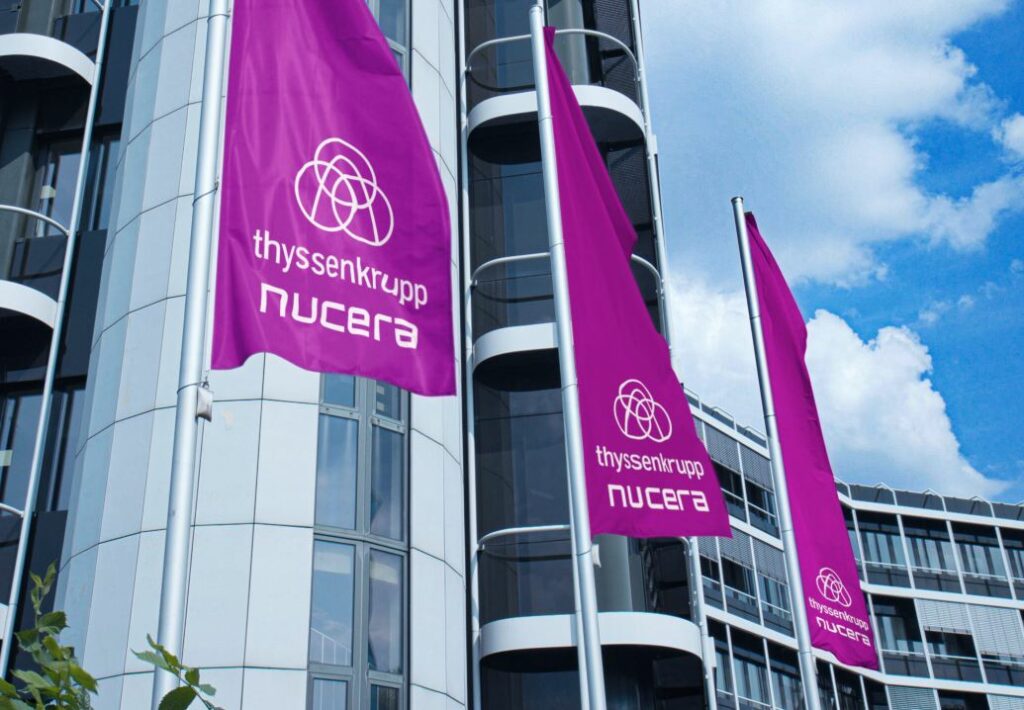Thyssenkrupp Nucera paid less than €10 million to acquire key technology assets from the insolvent Danish electrolyser manufacturer Green Hydrogen Systems, completing a strategic transaction that underscores the pressures facing smaller players in the alkaline water electrolysis sector. The deal, which includes intellectual property and a full-size prototype test facility in Skive, Denmark, reflects broader consolidation patterns in a market where the global alkaline water electrolysis market size is estimated at USD 1.75 billion in 2024, set to expand to USD 4.75 billion by 2033, growing at a CAGR of 11.73%.
The acquisition enables thyssenkrupp nucera to strengthen its pressurized alkaline water electrolysis capabilities, positioning the company to produce hydrogen at operating pressures up to 35 bar—a technical advancement that addresses industrial applications requiring compressed hydrogen without additional compression stages. This technology differentiation becomes critical as alkaline water electrolysis is expected to contribute 64.8% estimated share of the market share among electrolysis technologies.
Market Consolidation Amid Financial Pressures
Green Hydrogen Systems’ insolvency reflects the challenging financial environment facing emerging electrolysis manufacturers. The Danish electrolyser maker filed for bankruptcy after being unable to find a buyer for some or all of its business operations following a three-month in-court restructuring. Initial negotiations with thyssenkrupp nucera revolved around an acquisition of the entire Green Hydrogen Systems, but ultimately, only a selective asset acquisition proved viable.
The distressed acquisition price highlights the valuation pressures in the electrolyser sector, where capital-intensive technology development and scaling challenges create financial strain for smaller companies. Market projections vary significantly across research sources, with alkaline electrolysis market estimates ranging from $146.94 million in 2024 to $217.36 million in 2032 at a CAGR of 5.02% to more optimistic forecasts suggesting USD 10.5 billion in 2024 expected to reach USD 35.5 billion by 2032, growing at a 17.5% CAGR.
This wide variance in market size projections reflects fundamental uncertainties about demand scaling and competitive dynamics in the electrolyser industry. Established players with stronger balance sheets, like Thyssenkrupp Nucera, can capitalize on these uncertainties through opportunistic acquisitions of distressed competitors’ technology assets.
Pressurized Electrolysis Technology Advantages
The acquired pressurized alkaline water electrolysis technology addresses specific industrial requirements that conventional atmospheric pressure systems cannot efficiently serve. Operating at up to 35 bar enables direct integration with industrial processes requiring compressed hydrogen, eliminating separate compression stages that add cost and complexity to hydrogen supply chains.
This technical capability becomes particularly relevant for steel production, chemical processing, and other industrial applications where hydrogen pressure requirements typically exceed atmospheric delivery. The integration of compression capabilities within the electrolysis process improves overall system efficiency and reduces capital expenditure requirements for end users.
However, pressurized electrolysis systems face engineering challenges related to component durability, sealing technologies, and safety systems that increase manufacturing complexity compared to atmospheric pressure alternatives. The acquisition provides thyssenkrupp nucera with established solutions to these technical challenges, accelerating development timelines for commercial pressurized systems.
Strategic Positioning and Competitive Implications
The transaction reinforces thyssenkrupp nucera’s position among leading electrolysis technology providers while demonstrating how established players can leverage financial market disruptions to acquire complementary technologies at attractive valuations. The high single-digit million euro range purchase price represents a fraction of typical technology development costs for pressurized electrolysis systems.
The broader water electrolysis market shows stronger growth projections, with the global water electrolysis market size estimated to hit around USD 14.40 billion by 2034, increasing from USD 6.72 billion in 2024, with a CAGR of 7.92%. Within this larger market, alkaline electrolysis maintains cost advantages for large-scale applications despite higher efficiency offerings from proton exchange membrane (PEM) and solid oxide electrolysis technologies.
The acquisition enables thyssenkrupp Nucera to differentiate its alkaline offerings through pressurized capabilities while maintaining cost competitiveness relative to alternative electrolysis technologies. This positioning becomes important as industrial hydrogen demand scales and cost optimization remains critical for widespread adoption.
Technology Integration and Development Implications
The Skive test facility acquisition provides thyssenkrupp nucera with operational infrastructure for pressurized electrolysis validation and optimization, reducing the capital requirements for technology development and accelerating time-to-market for commercial systems. Full-size prototype testing capabilities enable performance validation under industrial operating conditions before committing to large-scale manufacturing investments.
Intellectual property acquisition reduces technology development risks while providing freedom to operate in pressurized alkaline electrolysis markets. Patent portfolios and technical know-how transfer enable thyssenkrupp nucera to avoid potential infringement issues while building on established technology foundations rather than developing pressurized systems from first principles.
The integration of Green Hydrogen Systems’ technology assets with thyssenkrupp nucera’s existing alkaline electrolysis platforms could create synergies in manufacturing, supply chain management, and technical support. However, successful integration requires careful management of technology compatibility and manufacturing process alignment to realize projected benefits.





